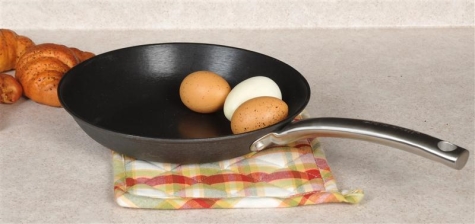I've been hearing about "light" cast iron cookware. The idea is intriguing—taking a heavy, solid, traditional cast-iron skillet and making it lighter and easier to handle. After all, my favorite cast-iron skillet checks in at more than 7 pounds.
But could a lighter pan, made with considerably less cast iron, really have the same ability to retain heat that produces perfectly seared steak and golden-brown fried foods?
 Well first, how is lightweight cast iron even possible? A traditional cast-iron skillet is made by pouring molten metal into a sand mold, which is broken apart when the pan cools, allowing the pan to emerge in one piece, handle included. By contrast, lightweight cast-iron pans are made in a metal mold, which allows them to be made thinner (and therefore lighter) and then machined or milled to thin them further. Their handles are attached separately with rivets.
Well first, how is lightweight cast iron even possible? A traditional cast-iron skillet is made by pouring molten metal into a sand mold, which is broken apart when the pan cools, allowing the pan to emerge in one piece, handle included. By contrast, lightweight cast-iron pans are made in a metal mold, which allows them to be made thinner (and therefore lighter) and then machined or milled to thin them further. Their handles are attached separately with rivets.
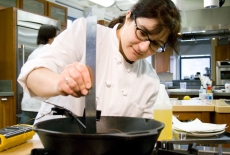 So wondering if there is even a "light" cast iron pan made that really delivers like the heavy duty stuff, I went to my favorite source of all-things-cooking information: America's Test Kitchen. Sure enough, they've checked this product out.
So wondering if there is even a "light" cast iron pan made that really delivers like the heavy duty stuff, I went to my favorite source of all-things-cooking information: America's Test Kitchen. Sure enough, they've checked this product out.
They tried three lightweight cast-iron skillets (ExcelSteel by Cook Pro 12-Inch Super Lightweight Cast Iron Frypan, Guy Fieri 12-in. Pre-Seasoned Light Weight Cast Iron Fry Pan, and the Starfrit Light Cast Iron Fry Pan), comparing them with their favorite traditional cast-iron skillet.
The Test Kitchen cooks are ruthless when it comes to product research, and their tests are varied and thorough. They included: shallow-frying breaded chicken cutlets, searing steaks, and making pan sauce with acidic tomatoes and capers to see if it would react with the iron surface, baking cornbread, cooking crêpes to check browning patterns, and scrambling batches of eggs in each pan before and after their other cooking tests to see if the cookware became more or less nonstick as they used them (the way traditional cast iron does).
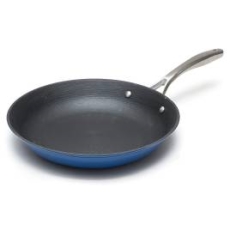 All of the pans were indeed lighter than a traditional cast-iron skillet-even if they still felt relatively weighty. Two were 4 pounds; the third weighed 2.65 pounds, about the same as their favorite stainless skillet. One pan had a black matte ceramic nonstick coating inside, which initially proved to be a real boon, releasing food perfectly, but it had lost much of its nonstick ability by the end of testing. Another pan lost its pre-seasoning quickly and didn't improve during their tests. The third pan was made entirely of pre-seasoned lightweight cast iron, and foods stuck fiercely to its surface, which became streaky and mottled-looking, and its hollow metal handle heated up like a chimney. By the end of all their tests, this pan had developed a thick patina inside and released much better, but it looked terrible.
All of the pans were indeed lighter than a traditional cast-iron skillet-even if they still felt relatively weighty. Two were 4 pounds; the third weighed 2.65 pounds, about the same as their favorite stainless skillet. One pan had a black matte ceramic nonstick coating inside, which initially proved to be a real boon, releasing food perfectly, but it had lost much of its nonstick ability by the end of testing. Another pan lost its pre-seasoning quickly and didn't improve during their tests. The third pan was made entirely of pre-seasoned lightweight cast iron, and foods stuck fiercely to its surface, which became streaky and mottled-looking, and its hollow metal handle heated up like a chimney. By the end of all their tests, this pan had developed a thick patina inside and released much better, but it looked terrible.
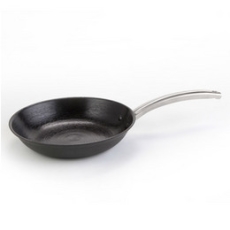 All three lightweight pans heated up and cooled down faster than the thicker traditional cast iron. While they were easier to lift and handle than the traditional pan, they were also far more reactive to heat changes, which caused them to cook much less evenly, with a distinct tendency to scorch along the outer edges. Only the smallest pan was able to compensate for these hot spots by being compact enough to transfer heat more quickly across its narrower cooking surface, lessening the opportunity for uneven browning. In the end, the only pan that gave the Test Kitchen chefs truly even browning and long-term durability was their traditional heavyweight favorite.
All three lightweight pans heated up and cooled down faster than the thicker traditional cast iron. While they were easier to lift and handle than the traditional pan, they were also far more reactive to heat changes, which caused them to cook much less evenly, with a distinct tendency to scorch along the outer edges. Only the smallest pan was able to compensate for these hot spots by being compact enough to transfer heat more quickly across its narrower cooking surface, lessening the opportunity for uneven browning. In the end, the only pan that gave the Test Kitchen chefs truly even browning and long-term durability was their traditional heavyweight favorite.
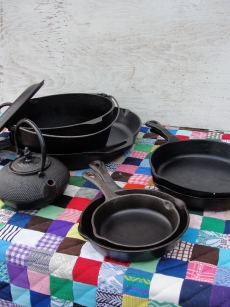 Their bottom line? Lightweight cast iron proved a disappointment. 'Nuff said. So "light" cast iron? Sure, but there's much more to a great pan than weight. Guess I'll save my money and keep hefting that cast iron I inherited from Aunt Annie—it's never let me down and I need the workout!
Their bottom line? Lightweight cast iron proved a disappointment. 'Nuff said. So "light" cast iron? Sure, but there's much more to a great pan than weight. Guess I'll save my money and keep hefting that cast iron I inherited from Aunt Annie—it's never let me down and I need the workout!
- www.lehmans.com
- www.kitchenwaresuperstore.com.au
- www.blogs.laweekly.com
- www.cooksillustrated.com
- www.shopping.yahoo.com
- www.daringbakerduluth.blogspot.com

Alice Osborne
Weekly Newsletter Contributer since 2006

